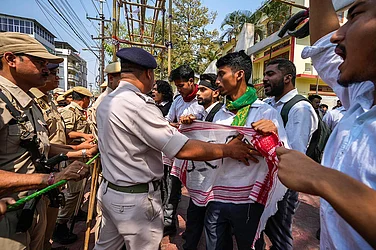It’s a hot, dusty, Delhi summer evening, and Rahul, a young graduate who works at a mobile repair shop in Shahdara, is going home to Sundar Nagari, a resettlement cluster where Arvind Kejriwal, the ‘everyman helmsman’ of the Aam Aadmi Party (AAP), started out with his social work initiative some years ago. In these eastern parts of the city, the party has created a certain presence, pegging itself to basic issues like poor water supply and lack of sanitation. Ask Rahul about the AAP and he vaguely speaks of Anna Hazare and Kiran Bedi having left Kejriwal. But a juice vendor has a verdict, well before the Delhi assembly poll, slated around the year-end. “AAP won’t make it to government, but it will gather some votes,” he says. “It has raised the right issues, after all.”
For the anti-corruption movement of 2011 that morphed tortuously into a political party, Delhi has become the testing ground. Party workers are trying their best to keep it in the public eye. After all, it’s a new party. It has to either attract disenchanted voters from elsewhere, or create a vote from its allegedly ‘apolitical’ fanbase. It has zeroed in on a bunch of ‘existential’ issues to forge its identity: power/water on the one hand, and the Nirbhaya/child-abuse cases or the anti-Sikh riots cases on the other. All the while keeping up a high-decibel, personalised attack on the ruling Congress, both at the Centre and in Delhi.
“Delhi will decide our future course of action,” says an AAP senior. “It’s do or die. A test to see how much public support converts into political faith.” Political scientist Yogendra Yadav, an AAP core committee member, feels the party will win 14 out of Delhi’s 70 assembly seats. One TV channel editor gives it 22.
As polls approach, the assessments are bound to change, but the real questions are: Is the party clear about its ideology? Does it have its realpolitik right? Is it structured, managed and administered well enough to really fight an assembly election? Is this in fact a prototype for whistle-blowers to make their fight political in a nation burdened by corruption? And the big one: Will it survive?
For now, AAP has adopted a twin strategy, one in Delhi, another for India. At a two-day national executive meeting last week, it discussed its still-evolving national agenda. As it tries to craft a coherent stand out of somewhat disparate tendencies on a confusing web of issues, an ‘ideology’ will presumably emerge. Or at least a platform. By now, it has a presence in 15 states, including Bihar, UP, Haryana, Punjab, Rajasthan, Madhya Pradesh, Maharastra and Orissa, with nearly all districts covered. The northeastern states have been clubbed as one unit; the doors to the south and Jammu & Kashmir haven’t opened yet—the latter perhaps pending a precise stand on the vexed issue. An organisational structure is being created, but hasn’t been formalised.
Its nascent form is no deterrent to the will to power, though. Sources say there is a strong demand for contesting the upcoming polls in Rajasthan and Madhya Pradesh, but the party isn’t too keen to spread its efforts. So for now, it’s Delhi as a pilot case and, on the basis of the lessons it offers, the big one of 2014.
The party constitution, in its present form, has somewhat nebulous political and economic language. Taking the grassroots approach from Swaraj, a book by Kejriwal, five sweeping categories have been created: democratic governance; economy and ecology; society and communities; culture, language and knowledge; and peace and security. Eighteen committees have been set up to look at these areas and their findings will crystallise into the party’s ideological line. “But it’s not going to be announced now, at least not before the Delhi assembly elections,” says a party member.
There’s no shortage of ticket-seekers, though. For Delhi’s 70 seats, the AAP has received nearly 500 applications. A screening committee—Sanjay Singh, Manish Sisodia, Vinod Kumar Binni, Dilip Pandey and Rajan Prakash—is vetting them. The process is interesting. Five applicants will be identified for each assembly seat. Their names will be put up in the public domain. Feedback will be sought from party volunteers by vote, and tickets will be given based on that.
In Delhi, the groundwork seems to be done. The BJP and the Congress are getting a bit worried about the AAP’s vote-cutting power. It has put in place 7,000 active volunteers and 40,000 local prabharis who are readying for an extensive door-to-door campaign. Already, small public meetings are being held daily. Kejriwal is not directly involved in the action, but is supervising overall efforts up from the booth-level.
On paper, all this sounds good. But a management-academic approach can work only if there’s electoral chemistry on the ground. Some sympathisers are worried that attacks by other parties—so far there have been few, but as elections approach they will increase—are going unanswered. There’s concern that the party line on vital issues, like Kashmir, is still a tad schizophrenic. Recently, AAP workers led protests against Kashmiris who had come to Delhi with their grievances. Contrary to this latent tendency to pop right-wingism, AAP leader Prashant Bhushan takes the liberal line and has even been manhandled for it.
Having non-career politicians in decisive posts poses other issues. The intellectuals who framed the party structure are abroad for extended trips. Yadav is fulfilling an academic commitment, so is Prof Anand Kumar, another ideologue. Their travels were opposed at the national executive and core committee meetings but they preferred to stick with their personal commitments. But the ‘outsider’ imprint is clear. Refreshingly, for instance, the ubiquitous caste/community criterion is absent from ticket-giving. Very idealistic. Will it work? Yadav’s psephologist peers will have the pleasure of evaluating his prediction post facto.


























